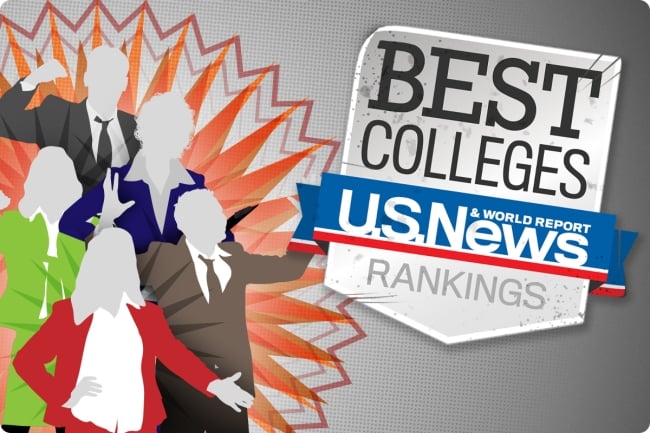You have /5 articles left.
Sign up for a free account or log in.

Changes to U.S. News’s rankings methodology bumped many public institutions up but evoked fierce criticism from some private college leaders.
Photo illustration by Justin Morrison/Inside Higher Ed | Getty Images | U.S. News & World Report
U.S. News & World Report released its annual rankings of undergraduate institutions Monday, prompting a familiar flurry of bragging and bemoaning by college leaders.
Inside Higher Ed does not typically cover college rankings, but this year’s list was determined using new methodology and seemed to ruffle more feathers than usual. Highly selective institutions like Princeton and Stanford Universities still occupy the top spots, but thanks to a beefed-up social mobility metric, a number of public institutions climbed significantly from recent years—and a similar number of private universities dropped, sometimes by double digits.
The social mobility metric isn’t a brand-new addition to the list; the rankings powerhouse began considering how institutions improve their graduates’ economic standing as a factor in 2018. But this year it placed a “greater emphasis” on outcomes and mobility, according to a press release from U.S. News, which called it “the most significant methodological change in the rankings’ history.”
U.S. News made the shift partly in response to criticism that it puts a premium on prestige, filling the top of the list year after year with wealthy, private, highly selective institutions. This year, open-access institutions with more low-income and minority students saw the benefits of the new metrics: the City University of New York’s City College and San Diego State University both jumped by 46 places, for instance, and a few—such as Rutgers University at Camden and Texas A&M University—cracked the top 50 for the first time.
At the same time, some private colleges with little socioeconomic diversity fell in the rankings. American University dropped by 33 places to No. 105, tied with City College and SDSU; Pepperdine University fell by 21 places, and Wake Forest University, formerly in the top 30, fell by 18.
A few of this year’s losers have publicly denounced the results as muddled and misleading, in some cases even implying it might be the final straw for their participation in the rankings.
‘Many Glaring Flaws’
Vanderbilt University, which fell from No. 13 to No. 18, responded by posting a message from Chancellor Daniel Diermeier excoriating the “lack of rigor and competence that has increasingly characterized U.S. News’ annual lists” and the “many glaring flaws” in the rankings’ new methodology—which, according to the university, were entirely responsible for its descent.
Diermeier told Inside Higher Ed that he considered it “important to speak out” and correct what he saw as a “deeply flawed” list.
“U.S. News has set aside well-established and standard measures of educational quality: class size, faculty qualifications in terms of the highest degrees and also [scores and grades] of the student body … That’s highly worrisome. And then the question of quality gets mashed into that of outcomes and affordability, and those measures are deeply flawed,” he said, noting that U.S. News did not take Vanderbilt’s income-driven debt-free program into account. “Choosing a college is already so complicated, so having clear information is critical for students and families … the information in U.S. News is misleading.”
Similarly, Oberlin College, which fell more than 10 spots to land out of the top 50 this year, sent a message from President Carmen Twillie Ambar saying that the rankings “fail to recognize excellence” and do a disservice to institutions’ distinct character.
Such reactions show that despite a series of high-profile defections and evidence that prospective applicants are increasingly apathetic about numerical rankings, U.S. News’s marquee product still occupies a prominent place in the marketing and self-image of many institutions. The blowback also reveals deepening ambivalence about that influence, as colleges’ long-simmering frustrations with the rankings threaten to boil over.
A spokesperson for U.S. News defended the outlet’s new methodology in an email, saying that outcome measures like postgraduation income and borrower debt are more important indicators of value than the traditional measures of student success and educational quality.
“We made changes to our rankings as appropriate and to reflect the changing landscape of higher education,” the spokesperson wrote. “We know that comparing diverse academic institutions across a common data set is challenging.”
Christopher Newfield, a higher education scholar and the research director of the Independent Social Research Foundation in London, said U.S. News’s methodology changes don’t actually address the main criticisms leveled at the rankings. If anything, he said, they confuse consumers by melding metrics of social mobility with entirely unrelated factors like selectivity and graduation rates. The list also presents changes in rank as signs of improvement or backsliding when—as the Vanderbilt statement noted—the methodologies change frequently enough to render year-to-year comparisons meaningless.
The persistent problem with U.S. News’s rankings, Newfield continued, is that they sell colleges as products, defined either by prestige or employment returns, rather than as intellectually fortifying experiences.
“Now the product that’s being sold is social mobility,” he said. “That’s an improvement over status and prestige. But neither of those things are about the intellectual, nonpecuniary benefits of a college education.”
Not everyone agrees, however—regardless of whether they approve of the new rankings metrics. Most Americans are skeptical of the inherent value of a college education, according to a 2023 study, and reluctant to invest in a degree whose connection to employment seems more tenuous than ever.
Havidán Rodríguez, the president of the University of Albany (part of the State University of New York)—which rose 48 spots to land at No. 70 on the rankings list this year—said the change represents an important acknowledgment of the work institutions like his are doing to serve underprivileged students and connect them to the workforce.
“I’m not one to focus on rankings, but the changes this year tell a pretty compelling story about the mission of higher education,” he said. “U.S. News is finally catching up.”
A Public Relations Paradox
Teresa Valerio Parrot, founder and principal of the higher education consulting firm TVP Communications, said the backlash to this year’s rankings connotes a kind of hypocrisy in colleges’ complicated relationship with a longtime sector giant like U.S. News.
“With rankings, sometimes you’re the windshield and sometimes you’re the bug. But it’s never good to force a teachable moment when you’re only interested in the actual outcome,” said Valerio Parrot. “I feel like we got to see a number of institutions who in the past have either been silent or have praised where they are in the rankings, and with this year’s methodology change suddenly have objections and grievances … that’s not really a great look.”
Diermeier said he understands why some saw his statement as petulant, considering the relatively small dip the institution took; Vanderbilt remains in the top 20. But he insisted that the substance of his critique is worth discussion.
“We did get the predictable reaction: ‘That’s sour grapes,’ ‘You’re a privileged institution,’ sure. The most important thing to me is that we have a serious debate about this,” he said. “Will we have information that allows our parents and students to make informed decisions about college choice? Or is this just an annual circus that’s a distraction for everybody?”
One middle-ground solution is to pay the rankings no mind whatsoever. That’s what 19 liberal arts college presidents swore to do in a 2007 letter, whose signatories included the former leaders of Williams and Amherst Colleges, the two most frequently top-ranked institutions on the U.S. News list of liberal arts colleges.
“We commit not to mention U.S. News or similar rankings in any of our new publications,” the letter read. “We are concerned about the inevitable biases in any single ranking formula, about the admissions frenzy and the way in which rankings can contribute to that frenzy.”
Jim Reische, Williams’s chief communications officer, said U.S. News’s recent methodological changes have not swayed the college to revisit its pact. And Scott Hood, the longtime senior vice president for communications at Bowdoin College, another signatory, said most of the undersigned colleges still refrain from mentioning their rankings in public statements.
But SUNY Albany’s Rodríguez noted it can be difficult to avoid addressing rankings, whether the news around them is positive or negative.
“Every year when they come out, I get many emails from alumni about it,” he said. “It’s hard for college leaders to ignore.”
Valerio Parrot said she understands why many institutions, especially those struggling to attract applicants, would amplify positive rankings results. But when it comes to responding to a disappointing result, she believes shrugging it off is the best strategy.
“So often, we in higher ed think this list is about us. And it is a review of us, but this is really about a for-profit news outlet making money,” she said. “We need to remember that the emotion we tie to this isn’t reciprocal.”
‘Growing Pressure’ to Withdraw
Some institutions refuse to provide data to U.S. News as a form of protest of its rankings. Just last year, four undergraduate institutions announced they would no longer participate: Colorado College, the Rhode Island School of Design, Stillman College and Columbia University, which made the decision after a math professor found inconsistencies in the data submitted to the magazine.
In their statements regarding this year’s rankings, both Vanderbilt and Oberlin threatened to join that group of conscientious objectors, citing years of frustration exacerbated by the shifting metrics.
“These radical movements in ranking positions are more indicative of how arbitrary the U.S. News rankings are rather than an indicator of a change in quality,” wrote President Ambar of Oberlin. “Higher education should no longer allow U.S. News rankings to influence the narrative about college quality and excellence in the United States. We will continue to evaluate what this means for Oberlin’s future participation in the rankings.”
Vanderbilt’s leaders made a similar veiled threat, referencing Columbia’s decision to withdraw and saying they are “considering our next steps.” The university’s law school and medical school already withdrew from those U.S. News rankings lists, part of a much more robust protest among law schools and other professional graduate programs.
The prospect of breaking from the rankings machine is still a hard sell. As the 2007 letter from 19 small colleges acknowledged, “No degree of protest may make [rankings] soon disappear.”
Diermeier was noncommittal when asked about the possibility of withdrawing Vanderbilt’s undergraduate program, but he said he hoped U.S. News took this round of complaints more seriously than in the past—and that he recognized a similar erosion of patience among his peers.
“We have expressed our concern forcefully and repeatedly, and we’re just being ignored,” he said. “We’re not quite sure what’s next, but we’re definitely going to re-evaluate … there’s growing pressure for sure.”
But Newfield said that until criticisms morph into action, they just provide more visibility for the rankings.
“We have to move away from this commercial product,” he said. “It’s an uphill battle, but it would really work a lot better if people like the president of Vanderbilt and presidents in general would commit to that instead of hand-wringing about the specifics.”





